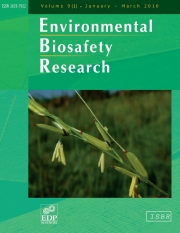Article contents
Facilitating co-existence by tracking gene dispersal in conventional potato systems with microsatellite markers
Published online by Cambridge University Press: 28 November 2007
Abstract
Based on international findings, Irish co-existence guidelines for the cultivation of GM potato stipulate that an isolation distance of 20 m is required to minimize the spread of transgenic pollen in accordance with required labeling thresholds. As potato tolerant to Phytophthora infestans is the most applicable GM crop from an Irish context, we tested the efficacy of this isolation distance under Irish environmental conditions using the conventional variety Désirée as a pollen donor and the male-sterile variety British Queen as a pollen receptor. Gene flow was determined by scoring for berry presence on receptor plants and confirmed using a microsatellite marker system designed to assess paternity in F1 seedlings. 99.1% of seedlings recovered were identified as having Désirée paternity. Whereas 19.9% (140/708) of total berries formed on receptor plants occurred at a distance of 21 m from the pollen source, only 4 of these berries bore viable true potato seed (TPS), from which 23 TPS germinated. TPS-bearing berry formation was negatively correlated with distance from the pollen source, and although overall distribution of berries and seeds was non-random across the plot, no significant correlation was evident with respect to wind direction. Microsatellite markers were also used to confirm that the foraging beetle Meligethes aeneus is a vector for the transmission of potato pollen, but a more detailed statistical analysis of this dataset was limited by inclement weather during the trial. To conclude, we recommend that a two-tiered system be established in regard to establishing isolation distances for the experimental trial and commercial cultivation of GM potato in Ireland, and that responsible crop management be adopted to minimize the establishment of TPS-derived volunteers, which we have noted will emerge through a rotation as a result of pollen-mediated gene flow.
Information
- Type
- Research Article
- Information
- Copyright
- © ISBR, EDP Sciences, 2007
References
- 4
- Cited by

